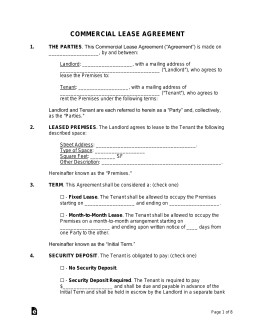Updated March 20, 2024
A commercial lease agreement is a legal document that binds a landlord and tenant to renting space for business activities. Unlike residential space, which is used for living purposes, commercial space is designated for offering products and services.
By State
- Alabama
- Alaska
- Arizona
- Arkansas
- California
- Colorado
- Connecticut
- Delaware
- Florida
- Georgia
- Hawaii
- Idaho
- Illinois
- Indiana
- Iowa
- Kansas
- Kentucky
- Louisiana
- Maine
- Maryland
- Massachusetts
- Michigan
- Minnesota
- Mississippi
- Missouri
- Montana
- Nebraska
- Nevada
- New Hampshire
- New Jersey
- New Mexico
- New York
- North Carolina
- North Dakota
- Ohio
- Oklahoma
- Oregon
- Pennsylvania
- Rhode Island
- South Carolina
- South Dakota
- Tennessee
- Texas
- Utah
- Vermont
- Virginia
- Washington D.C.
- Washington
- West Virginia
- Wisconsin
- Wyoming
Table of Contents |
By Type (12)
 Triple-Net (NNN) Lease Agreement – Tenant pays a base rent amount plus their pro-rata share of the property expenses. Triple-Net (NNN) Lease Agreement – Tenant pays a base rent amount plus their pro-rata share of the property expenses.
Download: PDF, MS Word, OpenDocument |
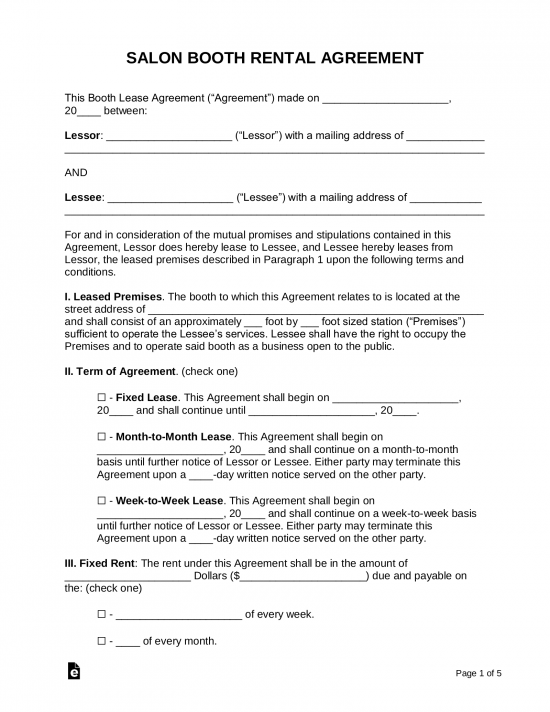 Booth (Salon) Rental Agreement – Tenant pays the owner of a business, typically a salon, to use a booth or area for cutting/coloring hair, massage, cosmetics, or nails. Booth (Salon) Rental Agreement – Tenant pays the owner of a business, typically a salon, to use a booth or area for cutting/coloring hair, massage, cosmetics, or nails.
Download: PDF, MS Word, OpenDocument
|
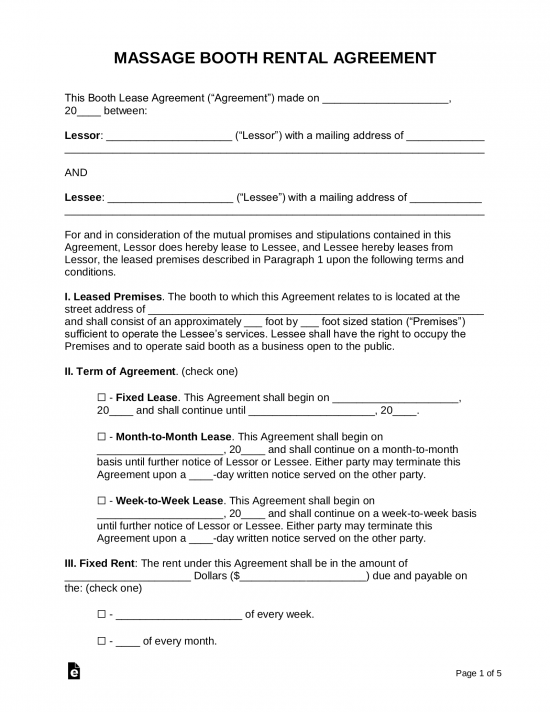 Booth (Massage) Rental Agreement – For a therapist who is seeking to rent a room or share space within a spa. Booth (Massage) Rental Agreement – For a therapist who is seeking to rent a room or share space within a spa.
Download: PDF, MS Word, OpenDocument
|
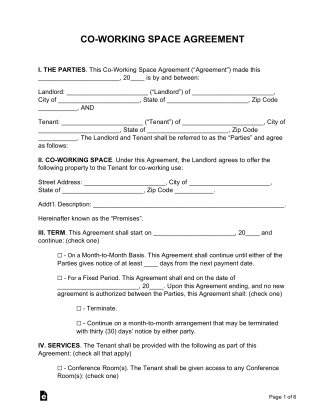 Co-Working Space Agreement – Mainly for shared office space amongst multiple tenants working in shared and dedicated areas. Co-Working Space Agreement – Mainly for shared office space amongst multiple tenants working in shared and dedicated areas.
Download: PDF, MS Word, OpenDocument
|
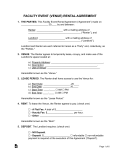 Event (Venue) Space Rental Agreement – An agreement to rent a setting for an event. Event (Venue) Space Rental Agreement – An agreement to rent a setting for an event.
Download: PDF, MS Word, OpenDocument |
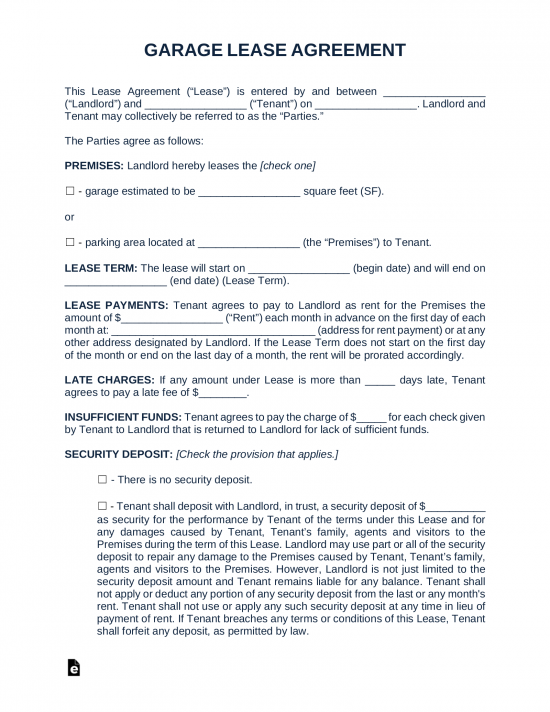 Garage (Parking) Rental Agreement – For renting a parking space on a monthly basis. Garage (Parking) Rental Agreement – For renting a parking space on a monthly basis.
Download: PDF, MS Word, OpenDocument |
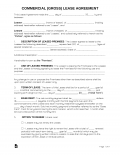 Gross Lease Agreement – The tenant only pays a monthly rent amount and is not responsible for property expenses. Gross Lease Agreement – The tenant only pays a monthly rent amount and is not responsible for property expenses.
Download: PDF, MS Word, OpenDocument |
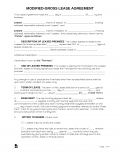 Modified-Gross Lease Agreement – The tenant only pays a monthly rent amount and is responsible for some property expenses. Modified-Gross Lease Agreement – The tenant only pays a monthly rent amount and is responsible for some property expenses.
Download: PDF, MS Word, OpenDocument |
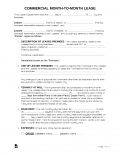 Month-to-Month Lease – A type of lease that can be cancelled, at any time, with 30 days’ notice. Month-to-Month Lease – A type of lease that can be cancelled, at any time, with 30 days’ notice.
Download: PDF, MS Word, OpenDocument
|
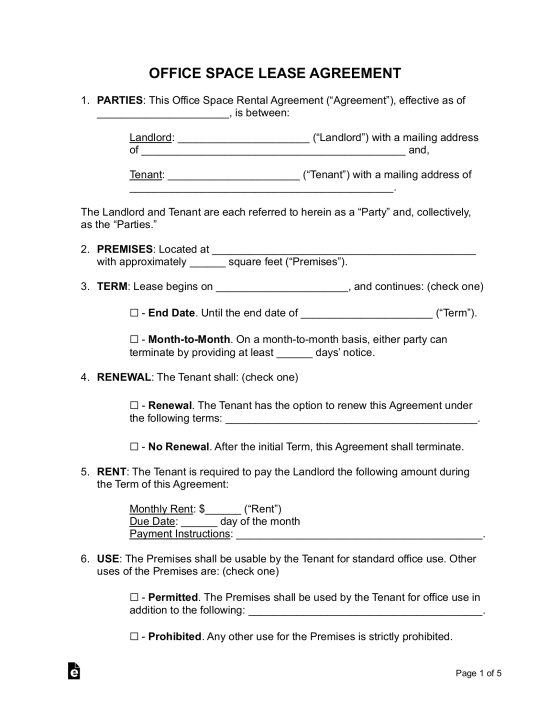 Office Lease Agreement – For the use of professional or tech-related uses. Office Lease Agreement – For the use of professional or tech-related uses.
Download: PDF, MS Word, OpenDocument |
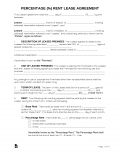 Percentage (%) Rent Lease Agreement – When a tenant pays rent calculated on a percentage of their sales. Percentage (%) Rent Lease Agreement – When a tenant pays rent calculated on a percentage of their sales.
Download: PDF, MS Word, OpenDocument |
 Sublease Agreement – Between a current tenant and someone else (subtenant) who agrees to rent the same space. Sublease Agreement – Between a current tenant and someone else (subtenant) who agrees to rent the same space.
Download: PDF, MS Word, OpenDocument
|
How to Lease Commercial Space (10 steps)
- Measure the Available Space
- Set the Rent ($/SF)
- Calculate the Property Expenses
- Hire an Agent (or market it yourself)
- List the Property Online
- Negotiating the Lease
- Conduct a Credit Check
- Approve or Disapprove the Tenant
- Write the Lease
- Tenant Takes Occupancy
1. Measure the Available Space

Commercial space is described as the available square feet (SF). The landlord can figure this out by measuring the length and width of the interior space.
Types of Commercial Spaces (5)
- Retail Space – Includes storefronts, restaurants, or any space where products or services are sold.
- Office Space – For any professional services.
- Industrial Space – It is commonly warehouse-related property used for manufacturing, maintaining, or distributing products.
- Hospitality Space – Refers to hotels, motels, or nightly rooms for travelers.
- Mixed-Use Space – Any combination of the above-mentioned types.
2. Set the Rent ($/SF)

Unlike residential property, which is calculated as a monthly amount, commercial space is commonly charged as a price per square foot ($/SF) paid over the course of 1 year.
Example
If the rent is $18/SF for a space of 1,000 square feet, the tenant would owe $18,000 during the course of 1 year, with $1,500 paid per month.
3. Calculate the Property Expenses
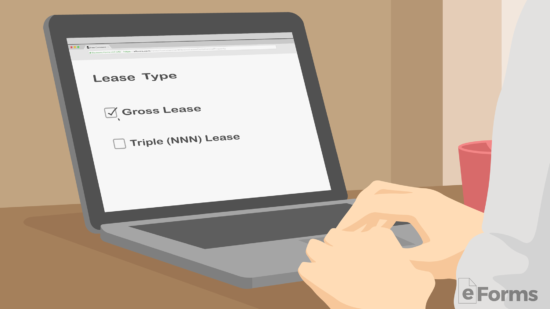
Depending on the property, the landlord may charge the tenant their prorated portion of the property expenses. This includes insurance, taxes, and common area maintenance (CAMs) related to the property.
The tenant’s portion of the property expenses must be calculated to present when marketing the property. This is usually obtained by mentioning the expenses for the previous year.
4. Hire an Agent (or Market it Yourself)

At this time, the landlord decides whether or not to market the property themselves or hire a real estate broker.
Average Commission (%)
A broker is paid based on the total lease amount multiplied by a commission percentage. There is no “average” commission rate and is illegal to set one under federal law.[1][2]
However, a landlord can expect to pay a commission of 4-6% for the first 5 years of the lease term and 1-3% for each year thereafter.[3]
Calculating a Commission
If a tenant agrees to rent property at an annual rent of $50,000 for 5 years ($250,000 total), the landlord must pay $12,500 based on a 5% commission rate.
Top 3 Commercial Agencies
- CBRE Group – 115,000+ brokers in 100+ countries.
- JLL – 102,000+ brokers.
- Cushman & Wakefield – 53,000+ brokers.
5. List the Property Online

The property should be listed online whether or not the landlord hired a real estate broker.
Top 5 Listing Websites
- LoopNet.com
- Crexi.com
- Craigslist.org
- CityFeet.com
- OfficeList.com (office space only)
6. Negotiating the Lease

Depending on the tenant, a landlord may be asked to construct a custom build-out of the property. This is often in exchange for increased rent.
Making a Non-Binding Agreement
A Commercial Lease Letter of Intent (LOI) should be executed after the landlord and tenant agree verbally to terms. It outlines the terms of an agreement, although it is non-binding.
7. Conduct a Credit Check

Unless a landlord is dealing with a national brand, a credit check should be performed to understand the tenant’s financial status. The tenant should complete a Commercial Rental Application.
Performing a Credit Check (2 Types)
- Business Credit Check (Experian) – $39.95 paid by the landlord.
- Individual Credit Check (Experian) – $19.95 paid by the tenant.
8. Approve or Disapprove the Tenant

It is time for the landlord to approve or reject the tenant. If approved, a commercial lease should be written.
If rejected, the tenant should be informed through a Tenant Rejection Letter.
If a Co-Signer is Required
Use a personal guarantee to get another individual to “co-sign,” which means they will also be liable if the tenant doesn’t pay rent or fulfill the responsibilities of the lease.
9. Write the Lease

Ensure that all the information about the property and the tenant is gathered and entered into the agreement. Once completed, the tenant and landlord should sign.
Notarizing a Lease
A notary acknowledgment allows a notary public to verify a signer’s identity when executing the lease.
10. Tenant Takes Occupancy

After the lease is signed, the tenant can take occupancy on the 1st day of the lease term (unless otherwise agreed). The tenant must maintain the property per the lease terms and pay rent each month.
Certificate of Occupancy
This is often required by a local government before a tenant can conduct business activities. For example, if the tenant sells food, the space will commonly need to obtain permits and undergo inspections before its grand opening.
Recommended Clauses (2)
Americans with Disability Act – Also known as the ‘ADA,’ requires that any commercial tenants who offer “public accommodation” (such as a restaurant, retail store, etc.) or have at least fifteen (15) employees adhere to all handicap access rules. This rule is only grandfathered to properties that have not been built or had renovations since 1992.[4]
Per 42 U.S. Code § 12183 if the Lessee is using the Premises as a public accommodation (e.g. restaurants, shopping centers, office buildings) or there are more than 15 employees the Premises must provide accommodations and access to persons with disabilities that is equal or similar to that available to the general public. Owners, operators, lessors, and lessees of commercial properties are all responsible for ADA compliance. If the Premises is not in compliance with the Americans with Disability Act any modifications or construction will be the responsibility of the Lessor.
Hazardous Waste – Forces the tenant to sign in writing that they will adhere to any federal, State, or local laws regarding the disposal of hazardous wastes.[5]
Shall mean any and all federal, state, or local laws, ordinances, rules, decrees, orders, regulations, or court decisions relating to hazardous substances, hazardous materials, hazardous waste, toxic substances, environmental conditions on, under, or about the Premises, the Building, or the Property, or soil and ground water conditions, including, but not limited to, the Comprehensive Environmental Response, Compensation and Liability Act of 1980 (CERCLA), the Resource Conservation and Recovery Act (RCRA), the Hazardous Materials Transportation Act, any other law or legal requirement concerning hazardous or toxic substances, and any amendments to the foregoing.
Sample
Download: PDF, MS Word, OpenDocument
COMMERCIAL LEASE AGREEMENT
1. THE PARTIES. This Commercial Lease Agreement (“Agreement”) made on [DATE], by and between:
Landlord: [LANDLORD’S NAME] with a mailing address of [LANDLORD’S ADDRESS] (“Landlord”), and
Tenant: [TENANT’S NAME] with a mailing address of [TENANT’S ADDRESS] (“Tenant”).
Landlord and Tenant are each referred to herein as a “Party” and, collectively, as the “Parties.”
2. DESCRIPTION OF LEASED PREMISES. The Landlord agrees to lease to the Tenant the following described space:
Street Address: [PROPERTY ADDRESS]
Square Feet: [#] SF
Type of Space: [PROPERTY TYPE] (retail, office, industrial, etc.)
Other Description: [ADDTL. DESCRIPTION]
Hereinafter known as the “Premises.”
3. INITIAL TERM. The term of this Agreement shall be for a period of [LENGTH OF LEASE] starting on [START DATE], and expiring at midnight on [END DATE] (“Initial Term”).
4. OPTION TO RENEW. The Tenant has: (check one)
☐ – No Option to Renew. This Agreement may only renew in an amendment to this Agreement or in a separate agreement.
☐ – Option(s) to Renew. The Tenant has the option(s) to renew this Agreement under the following terms: [DESCRIBE OPTION(S) TO RENEW]
The Initial Term and any renewal periods mentioned shall be collectively referred to as the “Term.”
5. SECURITY DEPOSIT. Under this Agreement: (check one)
☐ – No Security Deposit is Required. There shall be no deposit required for the successful performance of this Agreement by the Tenant (“Security Deposit”).
☐ – Security Deposit is Required. $[SECURITY DEPOSIT AMOUNT] payment is required by the Tenant and is due and payable in advance of the Term or at the signing of this Agreement (“Security Deposit”), whichever occurs first. The Security Deposit shall be held in escrow by the Landlord in a separate bank account as security for the successful performance of the terms and conditions of this Agreement. The Security Deposit may not be used to pay the last month’s Rent unless written permission is granted by the Landlord.
6. RENT. During the Initial Term, there shall be: (check one)
☐ – No Rent Increases. The Monthly Rent is: $[AMOUNT].
☐ – Increases in Rent. The Tenant shall be obligated to pay rent for the Initial Term in accordance with the following: [DESCRIBE RENTAL PERIODS]
Hereinafter known as the “Base Rent.”
7. PERCENTAGE RENT. In addition to the Base Rent, there shall be: (check one)
☐ – No Percentage (%) Rent.
☐ – Percentage (%) Rent. The Tenant shall be required to pay [#]% of [TYPE OF SALES] (gross sales, net sales, etc.). Such payment shall be made with a receipt and proof of calculation and paid each: (check one)
☐ – Monthly
☐ – Quarterly
☐ – Annually
Hereinafter known as the “Percentage Rent.” The Base Rent and the Percentage Rent shall be referred collectively to as the “Rent.”
8. LATE FEE. If Rent has not been paid on the Due Date, there is: (check one)
☐ – No Late Fee. The Tenant shall not be liable to pay a penalty for any late payment due under this Agreement.
☐ – A Late Fee. If the Rent is not paid within [#] days of the Due Date, the Landlord will charge a: (check one)
☐ – Flat Fee. The late fee is $[AMOUNT] and applied per: (check one)
☐ – Occurrence that Rent is Late.
☐ – Day that Rent is Late and until it is paid-in-full.
☐ – Based on Interest. The late fee shall be calculated based on the unpaid Rent amount and accumulating at an interest rate of [#]% per annum until paid-in-full.
All late payments made related to Rent shall be first applied to the late fee and all remaining amounts toward the outstanding Rent amounts.
9. PERMITTED USES. The Tenant agrees to use the Premises for: (check one)
☐ – All Purposes. The Tenant may use the Premises for any purpose legal under State and local laws.
☐ – Specific Purposes (only). [DESCRIBE PERMITTED USES]
Any change in the above-mentioned purposes of the Premises shall only be permitted upon the Landlord’s prior written consent.
10. SHARE OF PROPERTY EXPENSES. The Parties shall be obligated to pay for the following expenses related to the Premises:
Landlord’s Share of Property Expenses: [DESCRIBE]
Tenant’s Share of Property Expenses: [DESCRIBE]
11. LEASEHOLD IMPROVEMENTS. The Tenant is: (check one)
☐ – Not Allowed to Make Leasehold Improvements. The Tenant shall not be allowed to make leasehold improvements without the written consent of the Landlord.
☐ – Allowed to Make Leasehold Improvements. The Tenant shall be allowed to make leasehold improvements without the written consent of the Landlord.
12. GOVERNING LAW. This Agreement shall be governed by the laws in the State of [GOVERNING LAW].
13. NOTICES. Payments and notices shall be addressed to the following:
Landlord
Name: [NAME]
Address: [PROPERTY ADDRESS]
E-Mail: [E-MAIL ADDRESS]
Phone: [PHONE]
Tenant
Name: [NAME]
Address: [PROPERTY ADDRESS]
E-Mail: [E-MAIL ADDRESS]
Phone: [PHONE]
IN WITNESS WHEREOF, the Parties have indicated their acceptance of the terms and conditions of this Agreement by their signatures below on the dates indicated.
Landlord’s Signature: ________________________ Date: ____________
Print Name: ________________________
Tenant’s Signature: ________________________ Date: ____________
Print Name: ________________________
Tenant’s Signature: ________________________ Date: ____________
Print Name: ________________________

